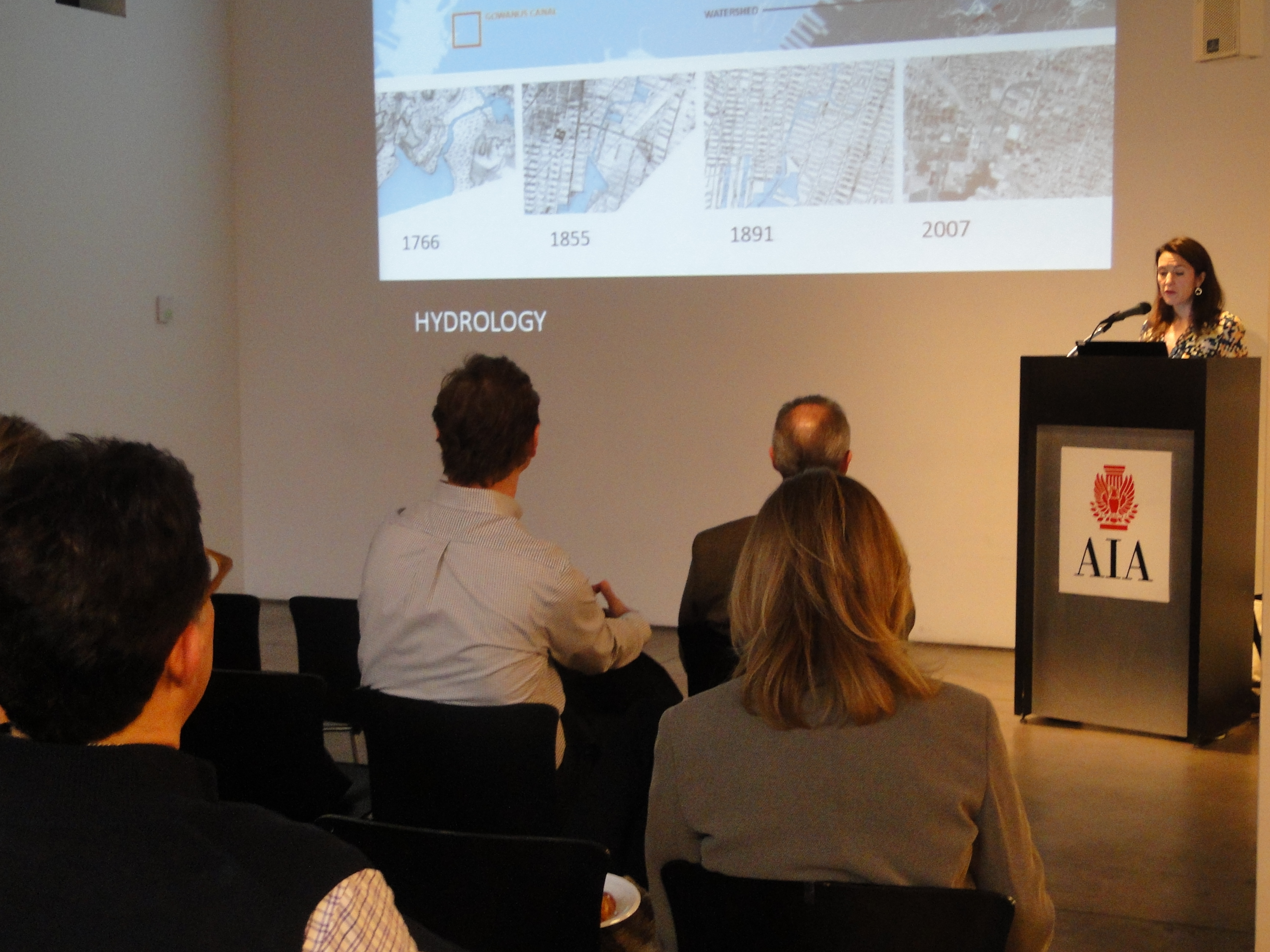by: Graham Higgins LEED AP
In a presentation on 01.10.14, organized by the AIANY Transportation and Infrastructure Committee, Susannah Drake, ASLA, AIA, founding principal of dlandstudio architecture + landscape, explored the resiliency of NYC’s infrastructure. As both a registered architect and a landscape architect, Drake’s work is particularly concerned with “urban ecological” infrastructure and, more generally, with achieving a fruitful balance between the urban and the natural. dlandstudio takes an integrated approach where collaboration amongst a variety of disciplines, from architecture to landscape architecture, ecology, scientific research, sculpture, planning, and engineering, is a vital component of design. Multidisciplinarity serves as the focal point of Drake’s design philosophy and is evident throughout dlandstudio’s contemporary project portfolio. Drake and her colleagues seek to redefine the divisions between buildings, infrastructure, and ecology to realize a holistic urban ecosystem of related parts. Such an approach is particularly relevant today, when a city’s resiliency and its ability to adapt to changing conditions on a variety of social, economic, and environmental scales is of paramount importance. Drake’s presentation addressed two areas of concern for the contemporary urban environment: stormwater management and greenspace optimization, both of which are crucial in enabling cities to adapt to the impacts of global climate change and respond to the effects of increasingly extreme weather events.
According to Drake, 27% of NYC’s physical footprint is comprised of paved hardscapes that pose a distinct challenge from a hydrological perspective. When water meets an impervious surface, it flows along the surface instead of being absorbed into the ground. This presents a range of issues, including the unwanted movement of pollutants and an overburdening of the sewer systems in many U.S. cities. Simply put, within the conventional urban environment, stormwater has become an expensive, complex, and cumbersome issue.
Such a deeply embedded challenge requires a holistic and multidisciplinary set of solutions. dlandstudio’s Hold System, deployed in Flushing Bay, Queens, is a vivid manifestation of Drake’s ideological design considerations. These systems, designed for easy transport and installation, are set to be placed in difficult-to-reach drainage areas beneath and adjacent to the Van Wyck Expressway. Modular green infrastructure plots absorb and filter out a variety of pollutants, such as oil and heavy metals, using a plant palate of hardy, indigenous, and drought-resistant species that thrive in New York’s environment. Such systems drastically improve the quality of the city’s stormwater, rendering it more manageable and far less harmful as it drains into waterways and other low-lying areas. These dynamic design responses address problems created by conventional design with innovative approaches that harness the ability of natural features to address the limitations of extant urban infrastructure.
In dense environments, greenspaces offer a range of benefits and opportunities for urban populations. The natural environment is capable of ameliorating hydrological issues and improving the civic experience. The Brooklyn Queens Expressway (BQE) was a component of Robert Moses’s attempt to mitigate traffic congestion and promote connection between all areas of the city. Unfortunately, as with many of the “master builder’s” projects, the BQE’s construction fractured many neighborhoods and relinquished New York’s celebrated pedestrian scale to raw automotive efficiency. Ultimately, and ironically, the project served to disconnect the communities through which it passed.
dlandstdio’s BQGREEN, supported by former City Councilwoman Diana Reyna and several city and state agencies, is a vision to cap two blocks of the BQE with flexible and open greenspace that can be used freely by the residents of Southern Williamsburg in Brooklyn. The proposal allows historical infrastructure to be reexamined in an ecologically-focused manner, and offers the potential to improve the adjacent communities. New greenspace also presents the opportunity to combat social issues such as poor physical and mental health. In addition, such spaces and their vegetation can offer carbon dioxide capture, peak temperature reduction, and the amelioration of air pollution through the filtration of airborne particulates.
If properly designed, greenspaces can also increase property values and catalyze positive development, as is the case with New York’s celebrated High Line Park. Coupled with its sister project, The BQE Trench: Reconnection Strategies for Brownstone Brooklyn, BQGreen represents a carefully crafted strategy that links Moses’s high-quantity infrastructural approach with Jane Jacobs’s high-quality infrastructural philosophy through design focused on harnessing the natural environment’s inherent productivity.
Through intelligent design and renovation of existing environments, cities like New York have the potential to simultaneously harness the cornucopia of benefits presented by the creative use of the natural environment, improve the civic experience of their citizens, and create more dynamic, adaptive, and resilient urban environments.
Graham is the Director of Project Resiliency for the New York City-based Development Management firm Cirgenski + Capalino and covers a variety of sustainability and resiliency issues concerning the built environment.
Event: Creating Resilience: Transformation of Urban Infrastructure
Location: Center for Architecture, 01.10.14
Speaker: Susannah Drake, ASLA, AIA, Principal, dlandstudio architecture + landscape
Organized by: AIANY Transportation and Infrastructure Committee









